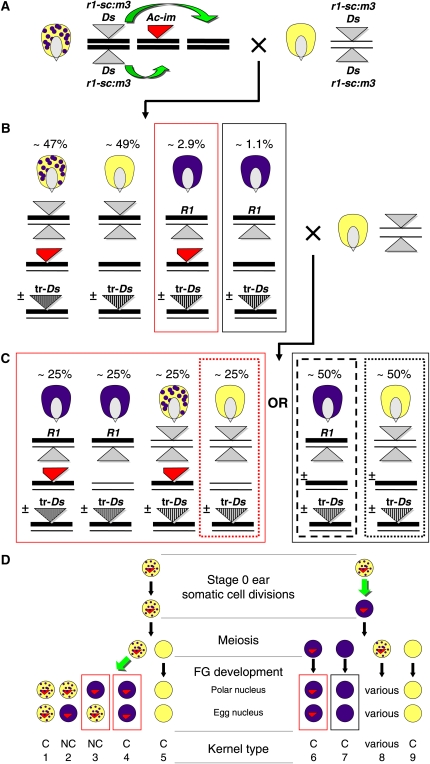Figure 1.
Pedigree Representation of Genetic Scheme to Enrich for Unlinked Ds insertions.
(A) Ds transposition, signified by the green arrows, occurs in stage 0 (zero) of the pedigree. Spotted kernels hemizygous for Ac-im (red triangle with a broken end) are sown and then test crossed to provide opportunity for the Ds element (gray triangle) in the r1-sc:m3 allele to transpose to new locations in the genome. Chromosomes from stage 0 plants are represented as thick lines to track them through subsequent generations.
(B) Putative stage 0 Ds transposition events are selected as fully colored stage 1 progeny kernels and test crossed to validate excision and detect segregating Ac-im elements. Each F1 (stage 1) ear segregates nearly 1:1 for coarsely spotted (inherited Ac-im) and colorless (without Ac-im) kernels. These ears also segregate a low frequency of fully colored kernels that arise from Ds excision in stage 0 to generate and transmit a functional R1 allele. If the excised Ds reinserted, then a transposed Ds (tr-Ds, barred gray triangle inserted into a stage 0–derived chromosome) may segregate into any stage 1 kernel class, as dictated by when the excision occurred and where the element reinserted (see text). Relative frequencies of each kernel class were calculated from our populations. All fully colored, stage 1 kernels are selected (red and black boxes) and test crossed again by r1-sc:m3 pollen, creating one stage 2 ear per putative Ds excision event.
(C) Stage 2 progeny are the source for cloning the stage 0 transpositions and for seed distribution. Each stage 2 ear either contains Ac-im (left, derived from red boxed kernel class in stage 1) or lacks it (right, derived from black boxed class in stage 1). Progeny kernels are selected from each stage 2 ear and sown for DNA isolation from the seedlings, to identify and clone inherited, transposed Ds elements. To select for unlinked transpositions, kernels without Ac-im (light dotted red and light dotted black boxes) are selected for DNA isolation. To enrich for transpositions linked to the revertant R1 allele from stage 0, fully colored progeny are selected only from ears that lacked Ac-im entirely (dashed black box). This selection program identifies stage 2 ears that segregate germinal Ds transposition(s) from stage 0, while excluding somatic reinsertions. Remaining kernels from stage 2 ears are retained as a source for the identified, new Ds insertions. Kernel class frequencies for stage 2 ears are estimated.
(D) Transposition in stage 0 may occur at various times in development, with different genetic consequences. Cells or cell lineages (large circles) are shown in the indicated tissues; a lineage is spotted and/or contains a red triangle when it carries Ac-im. At the r1 locus, a spotted or yellow lineage contains only the r1-sc:m3 allele, while a purple lineage contains an R1 excision allele. Arrows denote cell divisions during developmental stage. A green arrow indicates Ds excision from r1-sc:m3 occurring during cell divisions. Bottom rows of female gametophyte (FG) cells are fertilized to produce stage 1 kernels as in (B). When Ds excision occurs premeiotically (right side) Ac-im and the R1 excision allele segregate independently during meiosis, and after fertilization, all fully colored kernels are concordant (C), with pigmented endosperm and an R1 excision allele in the embryo (boxed, 6 and 7). If Ds excises after meiosis (left side) in FG tissue, then in the soma of the haploid gametophyte the nontransposing Ac-im neither is lost nor segregates away from R1 so the corresponding stage 1 kernels will always contain Ac-im. However, excision may occur during female gametophyte development (see Supplemental Figure 3 online), such that fertilized nuclei may or may not contain the R1 excision allele and progeny may be concordant (C; e.g., box 4) or nonconcordant (NC; e.g., box 3), respectively. Boxed FG genotypes, numbered 1 to 9, are colored to correspond with the progeny type they produce in (B).

